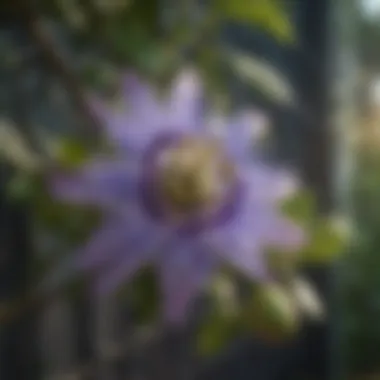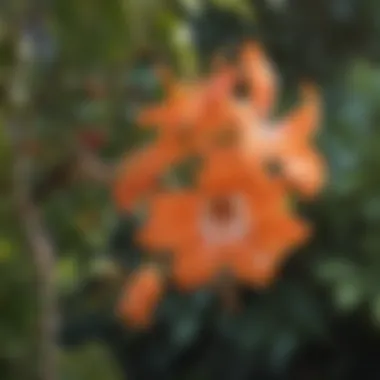Beautiful Flowering Vines for Florida Gardens


Intro
Florida's climate is unique. The combination of heat, humidity, and abundant sunlight creates a fertile ground for numerous flowering vines. These plants can serve multiple purposes, such as improving home aesthetics, providing privacy, or even supporting wildlife. Understanding which flowering vines thrive in this environment can open possibilities for creating stunning landscapes.
In this guide, we will explore various flowering vines that not only grow well in Florida but also add visual interest to any garden or home. The focus will be on specific species, their growth habits, care requirements, and integration in domestic settings. This information is valuable for both novice gardeners and experienced horticulturists who are looking to enhance their outdoor areas.
Through this examination, readers will find insights into the best practices for vine cultivation in Florida’s warm climate, along with innovative ideas on how to employ these plants in their designs.
Preamble to Flowering Vines in Florida
Flowering vines present a unique opportunity for enhancing the aesthetic appeal of gardens in Florida. They bring life, color, and texture to spaces that can otherwise appear monotonous. These plants are not just visually stimulating; they also offer various environmental benefits. Incorporating vines into landscaping can improve air quality, create habitats for local wildlife, and help regulate temperature by providing shade.
The Importance of Vines in Landscaping
Vines contribute significantly to the design of outdoor spaces. They can gracefully cover fences, walls, and trellises, transforming bare structures into lush, green backdrops. The ability of vines to climb and spread allows for creativity in garden design. Homeowners can create vertical gardens that optimize small yards, providing an illusion of space while adding vibrant hues.
Not only do flowering vines enhance visual interest, but they also support local ecosystems. They attract pollinators such as bees and butterflies, which are essential for biodiversity. In this way, the presence of flowering vines can contribute positively to the health of the surrounding environment.
Additionally, flowering vines have practical uses. They can act as natural sun barriers, cooling down areas of the garden during hot Florida summers. Their growth habits allow for privacy from neighbors without the need for tall fences. The right choice of vine can result in a beautiful blend of utility and beauty.
Climate Considerations for Planting
Florida's climate features warmth and humidity, but it also poses challenges for plant growth. When selecting and planting flowering vines, understanding local weather patterns is crucial. Most flowering vines prefer full sunlight, but a few can thrive in partial shade. Therefore, knowing the sun exposure of various areas in the garden is important.
Soil type also plays a vital role in the success of planting vines. Many vines favor well-draining soils to prevent root rot. It is essential to assess soil pH and texture before planting to ensure optimal growth. The humid conditions can also introduce pests and diseases. Homeowners should be prepared to manage these challenges through proper care techniques and pest management strategies.
In summary, understanding the significance of flowering vines and the specific climate conditions in Florida will enable gardeners to make informed choices, leading to healthy, thriving plants in their outdoor spaces.
This foundational knowledge allows for a strategic approach when integrating flowering vines into your landscape design.
Key Characteristics of Flowering Vines
Understanding the characteristics of flowering vines is crucial for anyone looking to cultivate these beautiful plants in Florida's unique climate. The way these vines grow, their preferred environments, and their flowering patterns dictate not only their aesthetic appeal but also their functionality in landscaping. Each species offers distinct features that can influence a gardener's choice based on specific needs and local conditions.
Growth Patterns and Habits
Flowering vines exhibit various growth patterns and habits that are essential for proper training and support. They can be categorized into two primary groups: climbing and trailing vines. Climbing varieties, such as Bougainvillea and Jasmine, often utilize tendrils or specialized growths that cling to nearby structures. In contrast, trailing vines, like Morning Glory, spread horizontally, covering large surface areas.
These growth habits play an essential role in landscape design, enabling creative vertical gardening options. Understanding whether a vine will climb or trail helps in selecting the right support systems, such as trellises, fences, or arbors. Additionally, many flowering vines can adapt to various conditions, which is an advantage for gardeners looking to fill spots in gardens, patios, or along walls quickly. Practicing regular pruning and training techniques also contributes to promoting healthier growth and prolonged blooming cycles.
Flowering Seasons in Florida
In Florida, the warm climate supports a dynamic range of flowering seasons for various vining species. The blooming periods significantly impact garden design and maintenance. Some vines, like Bougainvillea, are known for their prolific blooms, which can occur several times a year, particularly when adequately cared for.
On the other hand, certain species may have more specific flowering windows. For instance, the Passionflower typically blooms in the summer months, while Jasmine shows off its flowers mainly in spring. Understanding these seasonal variations allows gardeners to plan their landscape for continuous blooms, ensuring vibrant colors and scents throughout the year.
Choosing flowering vines with overlapping blooming periods can create an attractive and ever-changing visual display in any garden. This thoughtful integration enhances not only the beauty of a home but also the overall ecological health of the area as various species support local wildlife like butterflies and hummingbirds.
"Opt for flowering vines that provide both visual interest and ecological benefits. These plants serve as a dual purpose in enhancing aesthetic appeal and supporting local wildlife."
Popular Flowering Vines for Florida Gardens
Flowering vines are crucial for any landscaping project in Florida. They provide vertical interest, color, and fragrance to gardens. Furthermore, they help with energy conservation by acting as natural sun-blockers. When selected carefully, these plants can thrive in the warm, humid climate of Florida. Their ability to grow quickly makes them an attractive option for covering fences or creating privacy.
Bougainvillea
Description and Appearance


Bougainvillea is well-known for its bright, paper-like bracts, which can be magenta, purple, red, or orange. The actual flowers are small and white, surrounded by these colorful bracts. This combination creates a stunning visual impact. The vibrant colors can enliven any garden, making it a popular choice among gardeners.
Growing Conditions
Bougainvillea prefers full sun and well-draining soil. It is drought-tolerant once established, which makes it suitable for Florida's sandy soils. It does not require heavy watering, making it low-maintenance. However, moisture retention should be monitored, especially during prolonged dry spells.
Cultural Significance
In Florida, Bougainvillea represents tropical beauty and resilience. It is often used in public parks and private estates, signifying a warm, inviting environment. This plant's ability to thrive with minimal care resonates with gardeners seeking beauty without excessive maintenance.
Passionflower
Unique Features
Passionflower has an intricate bloom structure, featuring fringe-like petals and vibrant colors, which creates an exotic appearance. Its unique flowers are not only visually striking but contribute significantly to the local ecosystem. This plant's fast growth can quickly cover a trellis or fence.
Habitat Preferences
Passionflower grows best in full sun to partial shade. It requires regular watering but tolerates some drought. Its native habitat ranges from tropical to subtropical regions, making it a suitable choice for Florida gardens.
Butterfly Attraction
One notable aspect of Passionflower is its ability to attract various butterflies, especially the Gulf Fritillary. This feature makes it an excellent addition for those who appreciate biodiversity and wish to create a vibrant garden ecosystem. This attraction can also enhance the garden experience for homeowners and guests alike.
Jasmine
Varieties Common in Florida
There are multiple Jasmine species that flourish in Florida, such as Carolina Jasmine and Confederate Jasmine. These varieties are known for their unique climbing ability and dense foliage. They also offer beautiful flowers that can vary from white to yellow.
Fragrance and Uses
Jasmine is revered for its sweet, inviting fragrance. These qualities make it popular for romantic settings and evening gatherings. Homeowners often utilize it to create aromatic outdoor spaces, emphasizing the sensory experiences in their gardens.
Care Requirements
Jasmine requires well-drained soil and can thrive in a range of light conditions. Regular pruning helps maintain its shape and promotes dense growth. While it requires some care, the rewards justify the effort, as it can provide both beauty and fragrance to any garden.
Morning Glory
Growth Rate and Coverage
Morning Glory is cherished for its rapid growth and ability to cover structures quickly. Under ideal conditions, it can reach several feet in just a season. Quick coverage aids in providing privacy and shaded areas within the landscape.
Color Variations
This vine offers a rainbow of colors, from deep blue to vivid pinks. The range of colors can add dynamism to any garden. Gardeners can select specific colors to match their design preferences or personal taste.
Maintenance Tips
Morning Glory requires minimal care but benefits from regular deadheading. This helps promote more blooms throughout the season. Being aware of its vigorous growing nature ensures that it doesn’t overwhelm nearby plants or structures.
Clematis
Species Found in Florida
Clematis species, such as Florida native Clematis vine, are well adapted to local conditions. These species display a wide range of flower shapes and colors, diversifying the visual appeal in gardens. Their unique features make them distinct among flowering vines.


Optimal Growing Conditions
Clematis thrives in well-drained soil and prefers a balance between sun and shade. Several species can tolerate Florida's heat, provided they are given sufficient moisture. These growing conditions are essential for maximizing vigor and blooming potential.
Design Considerations
Integrating Clematis into garden design requires careful thought. Their climbing nature allows for creative placement on trellises and arbors. Utilizing them in design can add height and texture, enhancing an outdoor space's overall aesthetics.
With the right selection of flowering vines, Florida homeowners can create stunning landscapes that thrive in the local climate.
Planting and Care Techniques
Planting and care techniques are critical in ensuring that flowering vines flourish in Florida's unique climate. Understanding these techniques allows gardeners to create an environment where these plants can thrive. This section discusses the essential elements involved in planting, watering, fertilizing, and pruning flowering vines, ensuring that they can contribute beautifully to any landscape.
Soil Requirements
The foundation of any successful garden lies in the soil. Flowering vines prefer well-draining soil that is rich in organic matter. A pH level between 6.0 and 7.0 is usually ideal. Sandy loams are common in Florida, but they may need amendments to enhance nutrient content. Consider adding compost or well-rotted manure to increase fertility. Testing soil before planting is also beneficial to ascertain that it meets these conditions.
Here's what to consider for soil preparation:
- Test soil pH and nutrient levels
- Amend sandy soil with organic matter
- Ensure good drainage to prevent root rot
Watering Practices
Watering plays a significant role in the health of flowering vines. In Florida, the climate can be humid, but regular watering is still necessary, especially during dry spells. It is advisable to water in the early morning or late afternoon to minimize evaporation. Drip irrigation systems can also be effective as they deliver water directly to the roots.
Some criteria for effective watering include:
- Water deeply to encourage strong root development
- Monitor soil moisture with a simple test (insert finger an inch deep)
- Adjust watering frequency based on seasonal changes
Fertilization Strategies
The right fertilization strategy can enhance the growth and bloom of flowering vines. It's recommended to use a slow-release fertilizer that provides essential nutrients over time. During the growing season, typically spring and summer, a balanced fertilizer can support vigorous growth. Excessive fertilization can lead to lush foliage but fewer flowers, so balance is key.
Important points for fertilization:
- Choose a slow-release 10-10-10 fertilizer for balanced nutrients
- Apply in the growing season, following package recommendations
- Avoid over-fertilizing to prevent foliage overgrowth
Pruning Techniques
Pruning is vital for the health and aesthetics of flowering vines. Seasonal pruning can encourage new growth and more blooms. For many species, late winter or early spring is an optimal time to prune. Remove any dead or diseased wood and thin out areas that are too dense to improve air circulation. This also helps to maintain the desired shape and size of the vine.
Consider the following when pruning:
- Use clean, sharp tools to make clean cuts
- Prune to shape the vine and remove unwanted growth
- Research specific pruning needs for different vine species
Effective planting and care techniques ensure that flowering vines not only survive but thrive in Florida's climate, enriching the landscape with their beauty.
Integrating Vines into Home Design
Integrating flowering vines into home design offers significant aesthetic and functional benefits. These plants not only enhance the visual appeal of a space but also contribute to environmental sustainability. By incorporating vines into your landscape, you can create more dynamic and inviting outdoor environments. Vines are versatile and can adapt to various architectural styles, from traditional to modern, making them suitable for any homeowner.
Creating Vertical Gardens
Vertical gardens are becoming increasingly popular among homeowners looking to maximize their outdoor space. This technique effectively utilizes walls and fences, allowing for innovative landscaping solutions. Flowering vines such as Bougainvillea and Jasmine can grow along these surfaces, adding color and texture.
- Selection of Vines: When choosing vines for vertical gardens, consider their growth patterns and blooming seasons. For instance, Bougainvillea thrives in full sun and produces vibrant flowers, while Jasmine offers a fragrant addition.
- Structural Support: Install trellises or wire systems that support vine growth. The right structure encourages healthy growth and blooms, making maintenance easier.
- Microclimate Considerations: Vertical gardens can create microclimates, protecting plants from harsh conditions. The upward growth allows for improved air circulation, contributing to overall plant health.
- Design Cohesion: Aim for a cohesive look by matching plant colors with existing architectural elements. This integration can enhance the overall design aesthetic while providing visual interest throughout the year.


Enhancing Patios and Outdoor Living Spaces
Patios and outdoor living areas can greatly benefit from the addition of flowering vines. Vines can soften hard edges and create a sense of enclosure, making these spaces feel welcoming and completed.
- Overhead Coverage: Consider using flowering vines like Wisteria to create a natural canopy. This provides shade, creating a comfortable outdoor environment, especially during hot Florida summers.
- Wall Enhancements: Adding vines to fences and walls can transform ordinary surfaces into lush, living installations. This adds an organic feel while also enhancing privacy when desired.
- Seasonal Variability: Different species bloom at various times, meaning your outdoor space can be vibrant and colorful throughout the seasons, providing continuous beauty.
Using Vines for Privacy
Using flowering vines can help create privacy in outdoor spaces. This is especially crucial for urban areas where homes are closer together.
- Natural Barriers: Vines can serve as natural barriers against noise and sight from neighbors. Dense growth can obscure views while still allowing airflow through the foliage.
- Important Considerations: When selecting vines for privacy, consider how quickly they grow and how large they get. For instance, Climbing Fig can provide excellent coverage quickly.
- Maintenance Needs: While vines can effectively provide privacy, they require regular maintenance to prevent them from becoming overgrown or invasive. Regular pruning ensures they remain within desired boundaries.
Integrating flowering vines into your home design not only boosts the beauty of your landscape but also enhances functionality.
Challenges in Growing Flowering Vines
Growing flowering vines can transform any garden into a stunning display. However, it is crucial to recognize the challenges that one might face when cultivating these plants in Florida's unique climate. Understanding these challenges is important to ensure that your garden remains vibrant and healthy. Elements such as pests, diseases, and environmental stress can greatly affect the growth and appearance of flowering vines. By identifying potential issues early, gardeners can take proactive steps to manage problems effectively and enhance the beauty of their outdoor spaces.
Pest and Disease Management
Pest management is a significant concern for homeowners planting flowering vines. Certain pests, such as aphids, spider mites, and whiteflies, can infest these plants, leading to weakened growth or even plant death. Regular monitoring is essential. You can inspect leaves and stems for signs of damage or insect presence. Natural remedies like neem oil can be effective in addressing infestations without employing harsh chemicals.
Additionally, disease prevention is equally vital. Diseases such as powdery mildew or root rot can attack flowering vines, especially in humid conditions common in Florida. Here are some strategies for managing pests and diseases:
- Maintain Plant Health: Healthy vines are less susceptible to pests and diseases. Ensure they get proper sunlight, water, and nutrients.
- Companion Planting: Some plants can repel pests naturally. Research beneficial companions to plant alongside your vines.
- Regular Pruning: This helps improve air circulation and reduces humidity around the plants, thus lowering the risk of mildew and mold.
- Inspect and Remove Infected Parts: Quickly identify and dispose of any diseased leaves or stems to limit spread.
"Proactive pest and disease management enhances the overall health of flowering vines, leading to more productive growth and vibrant blooms."
Environmental Stress Factors
Environmental stress factors can be detrimental to the growth of flowering vines in Florida. High temperatures, humidity, and sandy soils can create stress for plants. Understanding these factors and how to mitigate them is crucial for gardeners.
Consider the following environmental stress factors:
- Heat Stress: Florida's intense summer heat can cause wilting or sunburn on delicate vine leaves. Providing partial shade during peak sun hours can help.
- Humidity: While flowering vines thrive in moisture, excessive humidity can foster diseases. Ensure good air circulation to prevent issues.
- Soil Quality: Many flowering vines prefer well-drained soils. Conduct soil tests to adjust pH levels and enhance nutrient content through compost amendments.
- Irrigation Practices: Over-watering can lead to root rot, while under-watering may cause dehydration. Implement a balanced irrigation schedule that reflects seasonal changes.
By addressing these environmental factors, gardeners can foster a more conducive atmosphere for their flowering vines. Appreciation of these challenges not only leads to better management practices but also allows for a richer, more rewarding gardening experience.
Culmination
The conclusion of this article encapsulates the discussion surrounding flowering vines suitable for Florida’s climate. These plants are more than mere decorative elements; they contribute significantly to the environment and overall aesthetics of homes. A key point highlighted throughout is the diversity found in flowering vines such as Bougainvillea and Passionflower, which not only beautify spaces but also support local pollinators. This dual function enhances biodiversity and provides a small, yet crucial, ecological benefit.
In considering installation, one must reflect on various factors: sunlight, soil type, and water requirements. Each vine species has unique preferences, making it essential for gardeners to align their choices with the local conditions. This level of understanding ensures the successful survival and flourishing of the vines, which is ultimately rewarding for homeowners in Florida.
Moreover, integrating flowering vines into home design can yield significant benefits. They can transform ordinary walls into verdant canvases, create privacy screens, and even contribute to energy savings by naturally cooling building exteriors.
"Embracing the use of flowering vines is not just an aesthetic choice; it is a step towards fostering harmony with the local environment and improving personal living spaces."
Thus, the future of flowering vines in Florida looks promising. With increasing awareness of their benefits, one can only expect more gardeners to adopt these vibrant plants into their landscaping practices.
Future of Flowering Vines in Florida
The future of flowering vines in Florida seems bright, driven by a blend of aesthetic appeal and ecological benefits. As climate change continues to reshape gardening practices, many cultivars are adapting, showing resilience to varying weather patterns. Garden centers and local nurseries are increasingly stocking native and climate-appropriate vines to support this trend.
Technological advancements in agriculture and gardening are also playing a role. Smart watering systems, soil health monitors, and organic pest control measures are becoming common, enabling better care for these vines. For instance, using drip irrigation can ensure that vines receive adequate moisture efficiently, aligning with Florida's sometimes unpredictable weather.
As more homeowners recognize the benefits of incorporating flowering vines, community initiatives and educational workshops on sustainable gardening should grow. These will focus on vine selection, maintenance techniques, and broader landscaping strategies that complement Florida's ecological systems.
Encouragement for Gardeners
For gardeners, embracing flowering vines is an invitation to explore creativity in outdoor spaces. They serve as living art forms, capable of transforming a dull fence or wall into a lively backdrop of colors and fragrances. Novice gardeners may find growing these vines particularly fulfilling as they witness rapid growth and flowering in their chosen conditions.
Regular maintenance is key, but most vines are forgiving and can thrive even with moderate care. The joy of seeing a vine entwine a trellis or cover an arbor can encourage one’s engagement with gardening principles. Besides the aesthetic benefits, many flowering vines attract valuable pollinators. This contributes to the larger ecosystem, highlighting the gardener's role in preserving biodiversity.
Therefore, consider this article as a gentle nudge for those who may hesitate. Let the vibrant life of flowering vines weave through your garden and home; the potential they bring is significant. Engage with your community, exchange experiences, and contribute to a greener Florida by planting these beautiful vines.















